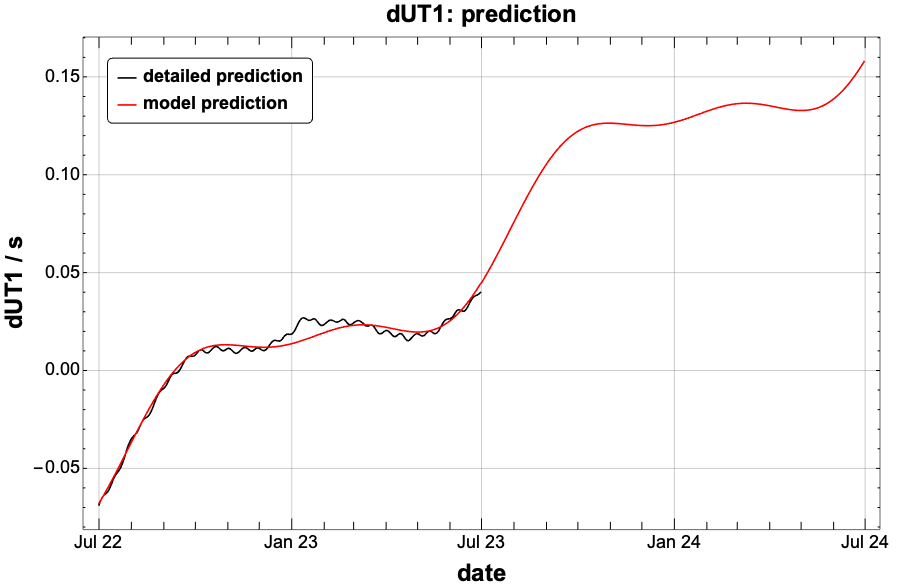IERS has just announced that no leap second will be inserted into UTC at the end of December 2022 (https://datacenter.iers.org/data/latestVersion/16_BULLETIN_C16.txt). The number of inserted leap seconds (since the inception of the leap second mechanism) remains at 37, and the difference between Terrestrial Time (TT) and Coordinated Universal Time (UTC) stays at:
dUTC = TT – UTC = 32.184s + 37s = 69.184s
This quantity is one of the ingredients required to perform eclipse computations. The time base for Besselian elements is usually TT, so the (nominal, non limb corrected) contact times computed based on such elements are naturally expressed in TT. But our clocks measure UTC time, hence the need for the time conversion from TT to UTC.
Another quantity which is required for eclipse computations is dUT1, which is the difference between Universal Time (UT1) and Coordinated Universal Time (UTC):
dUT1 = UT1 – UTC
The value of dUT1 is constantly changing, as it is directly tied to the fluctuations of the Earth’s rotation. Combining dUTC and dUT1, we can finally obtain deltaT, a quantity well known to eclipse chasers:
deltaT = TT – UT1 = dUTC – dUT1
deltaT is used in eclipse computations to convert between ephemeris longitudes and geographical longitudes.
Now that we have covered the basics, we can explore the predictions for dUTC and dUT1, and their relevance for the 2023 annular-total eclipse, the 2023 annular eclipse and the 2024 total eclipse. IERS provides both a forecast for dUT1 for the next 12 months, and a simple model to extrapolate predictions further into the future. The forecast and the model are published in IERS Bulletin A (https://datacenter.iers.org/data/latestVersion/6_BULLETIN_A_V2013_016.txt). The model takes the following form:
dUT1 = -0.0461 + 0.00031 (MJD – 59768) – (UT2 – UT1)
where MJD is the modified Julian Date (the Julian Date JD is the number of days elapsed from January 1st, 4731 BCE, proleptic Julian calendar):
MJD = JD – 2400000.5
and (UT2 – UT1) are know periodic terms:
UT2 – UT1 = 0.022 sin(2πT) – 0.012 cos(2πT) – 0.006 sin(4πT) + 0.007 cos(4πT)
where T is the date in Besselian years:
T = 1900.0 + (JD – 2415020.31352) / 365.24219878
The model is essentially linear, with superposed known periodic terms. What is regularly updated in each bulletin are the constant term and the slope of the linear part of the model (and the integer number to be subtracted from MJD, but that is really just a shift in time origin). From the latest IERS Bulletin A, the constant term is -0.0461 and the slope 0.00031. Worth of notice is that the slope is positive, so the current underlying linear trend is for dUT1 to increase, albeit at a very slow rate.
Now that we have laid out the simplified model to predict dUT1, we can crunch the numbers and plot the prediction. Here is the final result. In black are the daily prediction for the next 12 months, as provided in Bulletin A. In red is the prediction from the simplified model, that allows extrapolation past the 12 months horizon. The daily predictions are issued from a far more complex model. The simplified model does an egregious job in reproducing the daily predictions, and let us peer further into the future.

Bearing in mind that this is just a prediction, likely to degrade the further we go into the future, what can we deduce from this graph? We know that a leap second is added every time the dUT1 forecast is approaching -0.5s (more or less, there is some leeway). It has never happened, but a leap second would be subtracted if the dUT1 forecast were to approach 0.5s. According to this prediction, we are nowhere near reaching -0.5s (or 0.5s) until at least mid-2024. So it means that the number of leap seconds will stay at 37 till at least then, and the value of dUTC will be:
dUTC = 32.184s + 37s = 69.184s
for ATSE2023, ASE2023 and TSE2024. What about the value of dUT1? For ATSE2023, we have dUT1 ≈ 0s, and for ASE2023 and TSE2024 we have dUT1 ≈ 0.15s. In term of deltaT:
deltaT ≈ 69.2s for ATSE2023
and
deltaT ≈ 69.0s for ASE2023 and TSE2024
The interesting aspect of the simplified forecast model for dUT1 is that the slope of the linear term is positive. We are are used to see dUT1 decreasing, but nowadays dUT1 has a very gentle upward trend. If you are interested in some details on why that is happening, you can look at this post: Leap Second: will there be one before the 2023 AT eclipse? – Besselian Elements.
